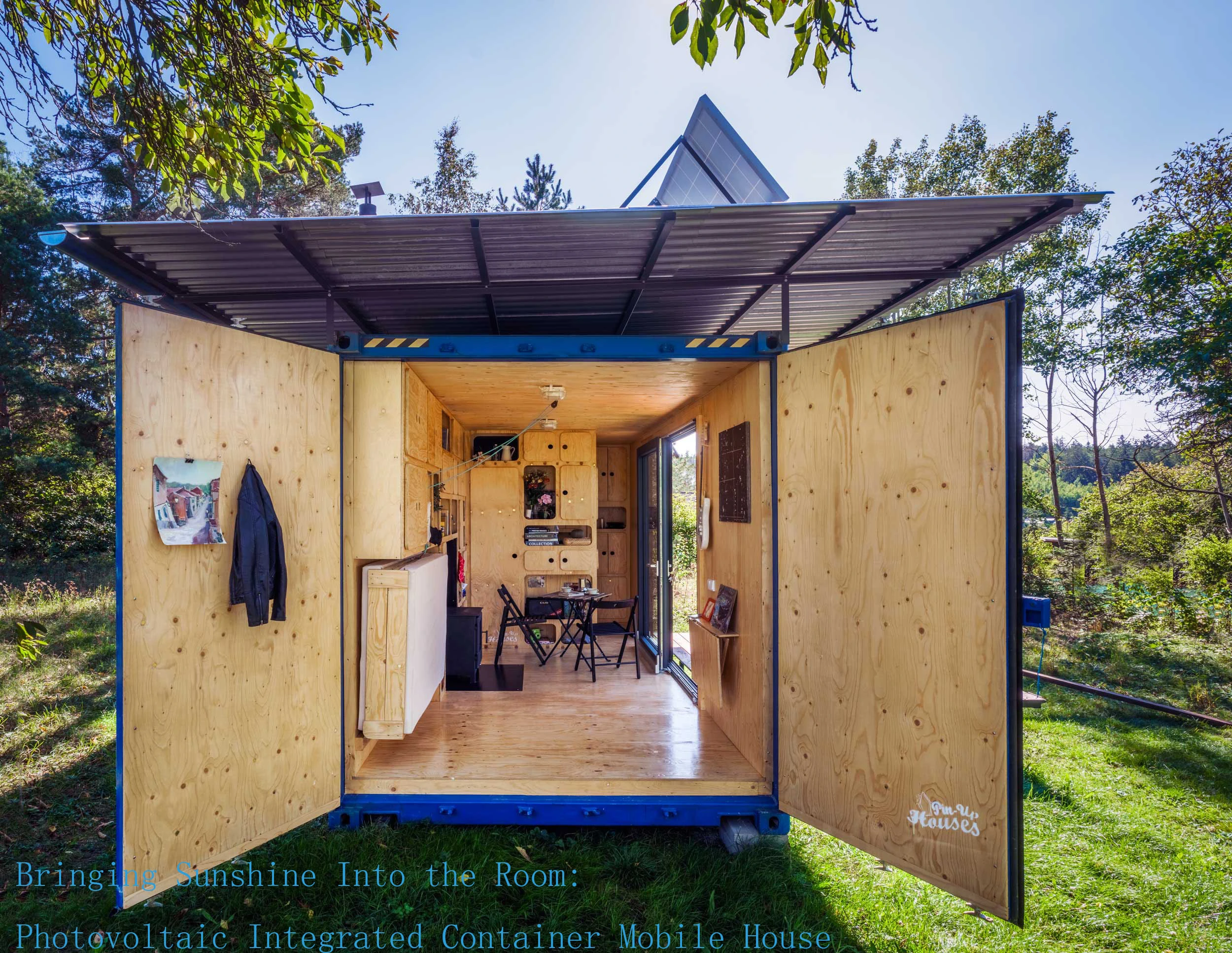Bringing Sunshine Into the Room: Photovoltaic Integrated Container Mobile House

Photovoltaic integrated container mobile houses, or solar-powered houses, are gradually becoming a new norm for green protection and energy self-sufficiency housing. This new residence beautifully integrates solar power supply systems, energy storage devices and minimum living facilities into a mobile house, not only fulfilling the masses' need for green power, but also promoting significantly the deployment mobility and space efficiency.
This mobile house is actually a refurbished single-layer or double-layer container with transparent and opaque solar panels installed on the roof, walls and windows. The solar panels are secured by H-shaped aluminum frames and special adhesives. The home is also equipped with an integral energy management system, including inverters, controllers, battery packs and junction boxes, to manage power generation and usage. The 50-liter roof water tank is used for daily domestic water needs, making a small and fully independent living environment.
Why is this design so important right now?
With higher public consciousness of sustainable development and countries actively pursuing clean energy policies, the photovoltaic container house solution fits a real and urgent need. For eco-tourism, short-term commercial application, off-grid region operations or disaster intervention, the solar container house with built-in power and water generation is able to provide electricity and water - two critical utilities - in standalone mode without reliance on traditional grid facilities. The system can function efficiently in mountain areas, seaside areas, forest areas or rural areas where there is unreliable or weak power supply. Sunlight is converted into usable AC electricity during the day and stored for use at night; water is also readily available through an internal tank system.
How It All Works
Instead of breaking this down into separate technical explanations, the system can be visualized holistically:
| Component | Purpose |
| Solar Panels | Semi-transparent on windows; opaque on roof and walls |
| Fixing System | H-shaped aluminum bonding structure anchors panels to container |
| Energy Management | Includes a junction box, inverter, battery, and controller for power flow |
| Water Storage | 50L stainless steel tank provides interior water supply via pipeline |
Electricity from the panels flows to a junction box, then to a controller. Depending on real-time load, energy is either sent directly to appliances via the inverter or stored in batteries. The water system, though simple in concept, is essential—especially for mobile living.
Compact Yet Capable: Benefits in One Look
Rather than arguing shelter merely at its most basic, the solar powered container house presents a synergism of innovation and practical comfort:
Environmentally Friendly Living: Solar energy + integrated water supply = reduced environmental impact.
Quick Deployment: Modular sizes (e.g., 6 × 2.4 × 2.6 m) are simple to ship; 6–8 modules can be shipped in a 40-ft container.
Aesthetic Attractiveness: Frameless panels create a sense of a glassy curtain wall.
One-Stop Utility: No individual power, water, or energy infrastructure to install on-site.
Heat Insulation: Light-transmitting panels also reduce exposure to indoor heat.
This is not only practical but also aesthetically pleasing—ideal for both rough terrain and urban installations.
Where It Fits Best
The versatility of this shipping container home makes it suitable for a variety of uses:
Eco-tourism and Glamping: Offer solar cabins in parks, beaches, or mountains.
Mobile Site Offices: Conduct work in construction sites or oil fields with assured power supply.
Pop-Up Kiosks: Operate pop-up shops, coffee shops, or display stands with off-grid dependability.
Emergency Response Shelters: Provide rapidly deployable housing for disaster areas.
These programs illustrate how the design combines portability and functionality, enabling individuals to live and work where there is sunlight.
What to Look for When Choosing One
If you're planning to deploy or purchase a photovoltaic integrated mobile house, consider the following design features:
Panel Type: A mix of thin-film and crystalline silicon ensures balance between aesthetics and output.
Energy Storage: Ensure the battery bank can handle expected daily load with backup reserve.
Water Needs: Larger families or work crews may require an upgraded tank or second system.
Structural Integrity: Bonding systems like H-shaped aluminum must meet local wind and load standards.
Climate Compatibility: Water and power systems must be weatherproof and thermally insulated.
By addressing these technical aspects in advance, users can enjoy long-term performance and durability in any environment.
Huijue Group’s Smart Solutions for Mobile Living
The building block of every successful solar container system is robust energy storage. This is the reason why Huijue Group offers premium Container Energy Storage Cabinets that are simple to incorporate with container houses. These systems possess:
Modular LFP Battery Packs: Long-life, stable output lithium iron phosphate cells.
Integrated BMS and EMS: Smart control systems for balancing energy inflow/outflow and safety surveillance.
Hybrid Inverter Compatibility: Smoothly supports both solar and generator input.
Compact Cabinet Design: Ideal for containerized spaces without sacrificing capacity.
Real-time Monitoring: Online access to data and smart fault protection.
Whether powering an off-grid home, office, or pop-up building, Huijue energy solutions guarantee safety, stability, and autonomy. Click to learn more, see our container energy storage solutions and solar container home case study.
